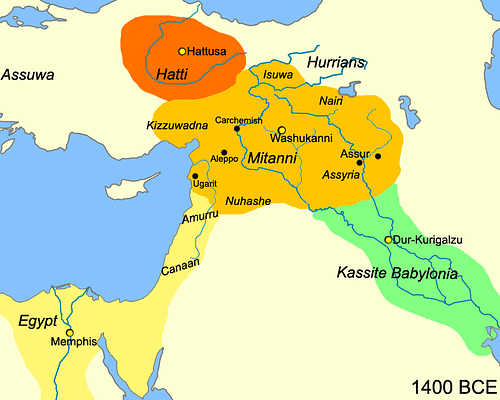 Hurrian?
Hurrian?
Posted on 03/13/2024 3:47:20 PM PDT by Cronos
Archaeologists have unearthed a 3,300-year-old clay tablet depicting a catastrophic foreign invasion of the Hittite Empire in Büklükale, about 100 km from Turkey’s capital Ankara.
A translation of the tablet’s cuneiform text indicates that the invasion occurred during a Hittite civil war, presumably in an attempt to support one of the fighting factions.
Previously, only broken clay tablets had been found in the excavations at Büklükale, but this one is in almost perfect condition.
Based on the typology and distribution of the collected pottery shards, Büklükale is thought to be a single-period city belonging to the Hittite Empire Period and having a diameter of 500 m.
The palm-size tablet was found in May 2023 by Kimiyoshi Matsumura, an archaeologist at the Japanese Institute of Anatolian Archaeology, amid the Hittite ruins at Büklükale.
The Hittites used the Hurrian language for religious ceremonies, Matsumura told Live Science, and it appears that the tablet is a record of a sacred ritual performed by the Hittite king.
“The find of the Hurrian tablet means that the religious ritual at Büklükale was performed by the Hittite king,” Matsumura told Live Science in an mail. “It indicates that, at the least, the Hittite king came to Büklükale … and performed the ritual.”
According to a translation by Mark Weeden, an associate professor of ancient Middle Eastern languages at University College London, the first six lines of cuneiform text on the tablet say, in the Hittite language, that “four cities, including the capital, Hattusa, are in disaster, ” while the remaining 64 lines are a prayer in the Hurrian language asking for victory.
The Hurrian language, which was spoken from the last centuries of the third millennium BCE until the Hittite empire’s final years (c. 1400–c. 1190 BCE), is now extinct and is not related to either the Indo-European or Semitic languages. Hurrian was originally the language of the region’s Mitanni kingdom, which later became a Hittite vassal state.
The language is still poorly understood, and experts have spent several months trying to learn the inscription’s meaning, Matsumura said.
It turns out, the Hurrian writing is a prayer addressed to Teššob (also spelled Teshub), the Hurrian name of the storm god who was the head of both the Hittite and Hurrian pantheons.
“It praises the god and his divine ancestors, and it repeatedly mentions communication problems between the gods and humans. The prayer then lists several individuals who seem to have been enemy kings and concludes with a plea for divine advice,” Matsumura said.
The Hittite Empire collapsed in the early 12th century for a variety of reasons, including civil war, climate change, and invaders such as the Sea Peoples, Kaskis, Phrygians, and Mycenaean Greeks pushing the borders of Hatti.
But it seems that the invasion indicated by the tablet has nothing to do with the end of the Hittite Empire. Matsumura said the tablet dates to the reign of the Hittite king Tudhaliya II, between about 1380 to 1370 B.C. — roughly 200 years before the Late Bronze Age collapse.
The tablet “seems to come from a period of civil war which we know about from other [Hittite] texts,” he said. “During this time, the Hittite heartland was invaded from many different directions at once … and many cities were temporarily destroyed.”
Although the Hittite Civil War is known as a period of civil war that destabilized the Hittite Empire in the last decades of its existence, it is understood that this problem has been ongoing since the past.
That’s not what happened at all. The name Hittite was taken from the Bible and turned out to be utterly unrelated to this so-called “forgotten empire”.
I see. Well, a lot of what happened in ancient times has been lost to history.
They used small print way back then like they do now in print magazines. Looks to be size 6, maybe even 4....
Is that the wallet size version?
Saving for later.
 Hurrian?
Hurrian?


The Hurrians are thought to have entered into the Near East in a series of waves in the Early or Middle Bronze Age, however their place of origin is uncertain, likely originating from somewhere in the Caucasus Mountains to the north.
Not so utterly destroyed, more forgotten.
Also, Hittite is an exonym - they called themselves Nešili or Nesians because they were the descendants of the people from Neša, which is the birth city of the Hittite dynastic culture. Otherwise they were called Hatti, which was mostly used by foreigners and refers to the people from Hattusa
That's why they had to hurry in................😁
Palm Pilot 0.3?
They could have been proto- Rush-ins also....no?
Took around 3,000 years to find the great Hittite empire. Wonder what other histories are buried....never to be found.
👌😁👍..........................
MS-DOS 2.0...............................
Over 90% of our knowledge of ancient history was lost when the Library of Alexandria was burnt to the ground by Muslims. It’s not known exactly how much, of course, because it was all lost. Only a fraction survived because copies were made. Since then, we’re like a person with amnesia, or Johnny Mnemonic.
Well, in this instance they are correct in climate change. Apparently, there was a very long and very extensive drought in the Mediterranean area during this period, which did disrupt many civilizations (since they were all agrarian based).
90 minutes: 1177 B.C.: When Civilization Collapsed | Eric Cline
https://www.youtube.com/watch?v=M4LRHJlijVU
Great link, thanks!
Disclaimer: Opinions posted on Free Republic are those of the individual posters and do not necessarily represent the opinion of Free Republic or its management. All materials posted herein are protected by copyright law and the exemption for fair use of copyrighted works.